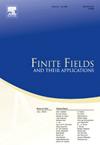有限域,其成员是幂次域和4幂次域的和
IF 1.2
3区 数学
Q1 MATHEMATICS
引用次数: 0
摘要
我们对有限域Fq进行了分类,这些域的成员是一个n强元素和一个4强元素的和。结果表明,恰好有十个非平凡对(q,n)存在这种情况。这是Abyzov等人(2024)[1]最近发表的一篇文章的延续,其中对三能性版本进行了深入研究,因为它扩展了Abyzov和Tapkin(2024)[1]建立的这一研究领域的最新成果。本文章由计算机程序翻译,如有差异,请以英文原文为准。
Finite fields whose members are the sum of a potent and a 4-potent
We classify those finite fields whose members are the sum of an n-potent element with and a 4-potent element. It is shown that there are precisely ten non-trivial pairs for which this is the case. This continues a recent publication by Abyzov et al. (2024) [1] in which the tripotent version was examined in-depth, inasmuch as it extends recent results in this seam of research established by Abyzov and Tapkin (2024) [4].
求助全文
通过发布文献求助,成功后即可免费获取论文全文。
去求助
来源期刊
CiteScore
2.00
自引率
20.00%
发文量
133
审稿时长
6-12 weeks
期刊介绍:
Finite Fields and Their Applications is a peer-reviewed technical journal publishing papers in finite field theory as well as in applications of finite fields. As a result of applications in a wide variety of areas, finite fields are increasingly important in several areas of mathematics, including linear and abstract algebra, number theory and algebraic geometry, as well as in computer science, statistics, information theory, and engineering.
For cohesion, and because so many applications rely on various theoretical properties of finite fields, it is essential that there be a core of high-quality papers on theoretical aspects. In addition, since much of the vitality of the area comes from computational problems, the journal publishes papers on computational aspects of finite fields as well as on algorithms and complexity of finite field-related methods.
The journal also publishes papers in various applications including, but not limited to, algebraic coding theory, cryptology, combinatorial design theory, pseudorandom number generation, and linear recurring sequences. There are other areas of application to be included, but the important point is that finite fields play a nontrivial role in the theory, application, or algorithm.

 求助内容:
求助内容: 应助结果提醒方式:
应助结果提醒方式:


